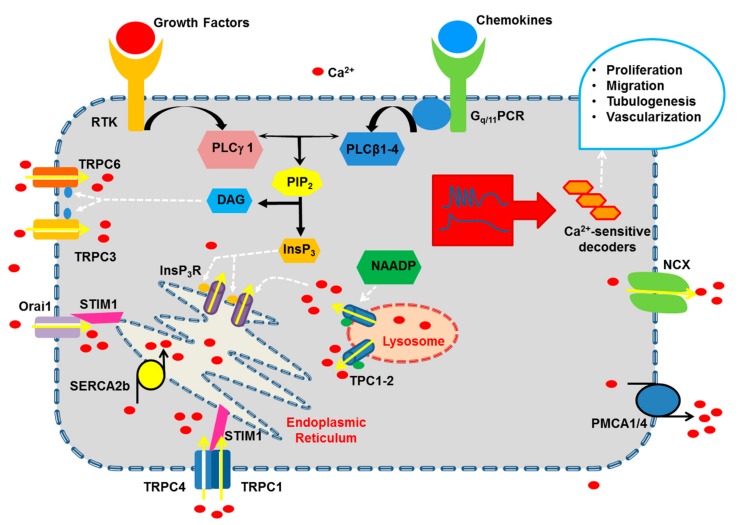Figure 1.
The pro-angiogenic Ca2+ toolkit in vascular endothelial cells. Pro-angiogenic cues, such as growth factors and chemokines, bind to specific receptor tyrosine kinases (RTK) and Gq/11-protein Coupled Receptors (Gq/11PCR) thereby activating multiple phospholipase C (PLC) isoforms, which in turn cleave phosphatidylinositol 4,5-bisphosphate (PIP2) into inositol-1,4,5-trisphosphate (InsP3) and diacylglycerol (DAG). InsP3 triggers Ca2+ release from the endoplasmic reticulum (ER) through InsP3 receptors (InsP3R), while DAG stimulates extracellular Ca2+ entry through TRPC3 and TRPC6. However, the major Ca2+-entry pathway in vascular endothelial cells is provided by store-operated Ca2+ entry (SOCE), which is mainly mediated by the physical interaction between STIM1 and Orai1. In addition, SOCE may be sustained by the interplay among STIM1, Transient Receptor Potential (TRP) Canonical 1 (TRPC1) and TRPC4, with [35] or without the involvement of Orai1. Endogenous Ca2+ release may also be sustained by ryanodine receptors (RyR, not shown) and by endolysosomal two-pore channel 1-2 (TPC1-2), which are gated by nicotinic acid adenine dinucleotide phosphate (NAADP). Multiple Ca2+-transporting systems maintain resting Ca2+ concentration and clear cytosolic Ca2+ after the pro-angiogenic signal. These include Sarco-Endoplasmic Reticulum Ca2+-ATPase 2a (SERCA2a), Plasma Membrane Ca2+-ATPase 1 (PMCA1) and PMCA4, and Na+/Ca2+ exchanger (NCX). Please, see the text for a more detailed description of how the endothelial Ca2+ toolkit is recruited by pro-angiogenic cues.

